

When Dona and I got dropped off at our house near Ponhofi school, it seemed like we had too much stuff. Too much stuff to be hauling across the sand to the house, and too much stuff to fit into our small room in the house. We were greeted by our "house mother", Martha, and three younger family members: Maria, Josephine, and Nafta (a.k.a. Tuyoleni). Maria was one of Martha's daughters; and for a long time we thought Josephine and Nafta were also Martha's children. But over time we learned that Namibian family arrangements aren't necessarily the same as ours here in the U.S.A., and Josephine and Nafta were a neice and nephew.
It is not uncommon for children of young Namibian single mothers to be left with Aunts and Uncles, as it is difficult for single moms to care for them, make ends meet, and go to school.
We were put at ease by Martha, who spoke excellent English; and we soon learned that Maria, Josephine and Nafta did also. It made us feel pretty inadequate, with our 25 words of Oshikwanyama.
 |
 |
| Maria, Dona, Gary, Josephine, and Martha | |
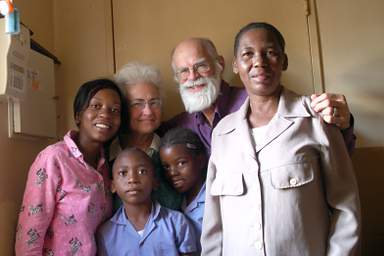 |
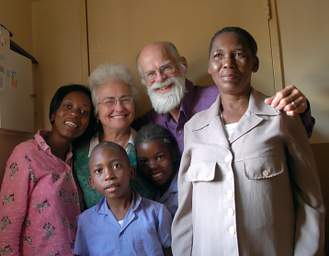 |
| Maria, Dona, Gary, Martha, Nafta, and Josephine | |
Ponhofi Secondary School serves grades 8 through 12 and has about 1200 learners. In Namibia, students are referred to as learners. I'm not sure where that came from, but probably from something the British say. But according the my on-line thesaurus, a student is a learner enrolled in an educational institution. So all students are learners, but not all learners are students. We should all be life-long learners, so it's not a bad label for kids in school. In any case, about two-thirds of Ponhofi's learners live too far away to walk to school on a daily basis, so they board at the school. The school has a front gate with a guard, and is surrounded by a razor wire fence for the childrens' safety.
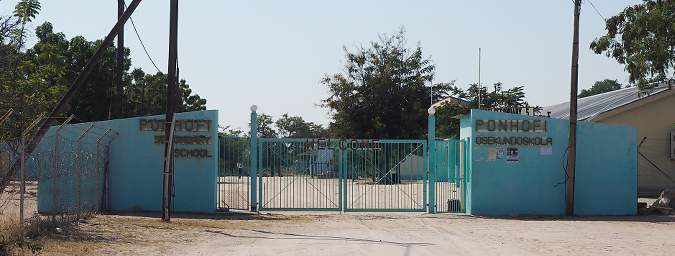 |
| Ponhofi Front Gate |
 |
Our days began at 07:30 with a staff meeting; classes started at 08:00. Staff meetings were sometimes a bit long, belaboring minor points on which it seemed like someone should have just made an executive decision. They always ended with some form of Christian prayer or bible reading, which seemed inappropriate given the Namibian Constitution's guarantee of non-discrimination on the basis of religion. It's unsurprising, however, given that 80% - 90% of the people are Christians and many Christians seem to feel it's their duty to impose their religion on the rest of the world.
My friend and high school English teacher, Wayne Connaway, tells a story of his year teaching in one of the Baltic countries; I can't remember which one. In any case, on the first day he was given a piece of chalk; it was expected to last the term... We were more fortunate. There was a big basket full of chalk in the faculty room; I grabbed at least one stick a day. Sometimes I would go through a whole piece in one class. I had a new mantra for a while, "Got chalk?"
About a week into our teaching, one of Dona's learners indicated they would be doing some singing and dancing one evening. As we left the Biology Lab one evening, we heard some faint music coming from across the school yard. Following our ears, we came to a classroom where all the desks had been pushed back and some learners were having a great time. The music, a cappella, was outstanding.
I took some photos and then realized I had video capabilities on my camera:
| Ponhofi Learners Singing and Dancing
(short version) |
| (long version) |
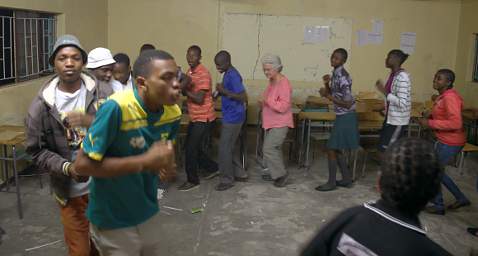 |
| Man, you just want to jump up and wiggle!
(Dona enjoying herself too...) |
Namibian society is a mixture of old and new, sometimes determined by financial situations, and sometimes just a result of historical norms, habits and the particular situation. Our house was a case in point.
There was a color television in the family room, and we had a gas and an electric range and a microwave; yet the roof clearly leaked in several places and the ceiling was missing in places, perhaps as a result of being torn up to try to find a leak.
I was delighted to discover an on-demand hot-water heater in the bathroom, but when we went to start a bath the first time it didn't work. I mentally wrote it down as something to fix, but upon closer inspection I discovered the propane piping had been severed where it came into the building and it had clearly been abandoned. If we had been staying longer, I would have tried to find time to fix it.
As in some parts of the United States of America, the doors and all windows had bars on them. The doors were locked at night, and the iron grill door was padlocked. When the kids were home alone, they kept the doors locked as well. The lock and padlocks made it a guaranteed fire-trap, something we thought about more than once.
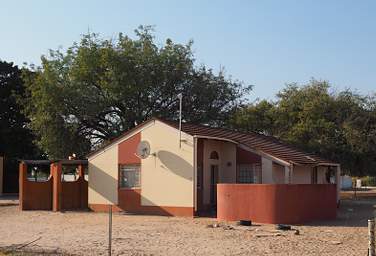 |
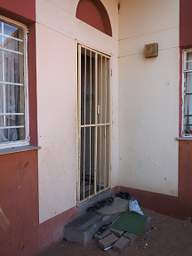 |
| Our Ponhofi Home | Front Door of our House |
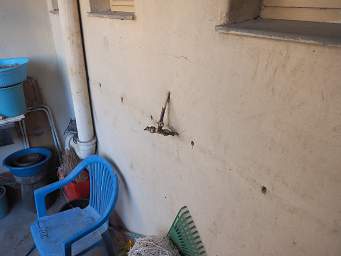 |
 |
| Hot-water Propane Connection... not | Ceiling |
Namibian childrean often have large responsibilities; much like it was here several generations ago. While some U.S. children carry similar responsibilities, I don't think it's the norm. In any case, Josephine, age 11, often cooked for the whole family. She did a good job too!
 |
 |
| Ponhofi Josephine Cooking | Microwave Transistor Shortwave |
While you see ground grain of various varieties in stores, all of the families we interacted with ground their own. Many families have a small farm and typically raise millet ("Mahangu" in Oshikwanyama). The millet is ground with a mortar and pestle. The resulting flour is cooked into a cream-of-wheat like porridge.
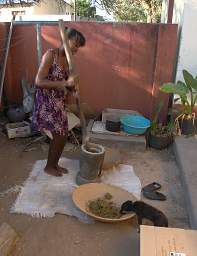 |
 |
| Martha Grinding Millet | Grinding Millet |
One evening during our first week, Dona and I sat down at the table to play banagrams. We didn't ask Josephine and Nafta if they wanted to play because we figured it would be too difficult for them, as English wasn't their first language and there weren't enough Os to do things in Oshikwanyama. But right away they wanted to play, so we played teams with one of them helping each of us. They did amazingly well, and always wanted to play whenever they could. We had also brought some jigsaw puzzles to help with geography, which we left with Dona's office-mate, a geography teacher. We had one for each of the continents, and one of Namibia with the regions (like U.S. states) as the pieces. The kids loved doing them at the table too.
 |
 |
| Josephine and Nafta playing Bananagrams | |
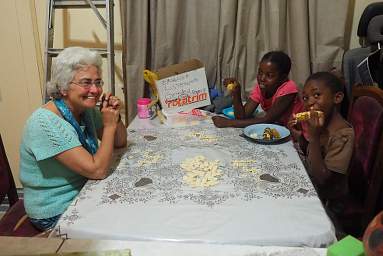 |
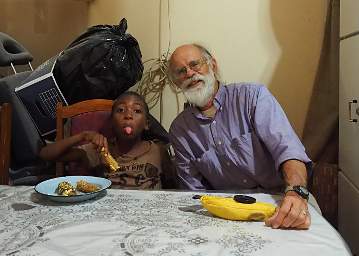 |
| Dona, Josephine and Nafta (Tuyoleni) | I did the same thing when I was a kid... |
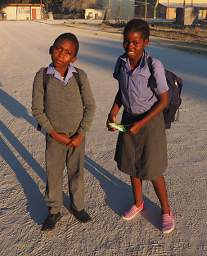 |
 |
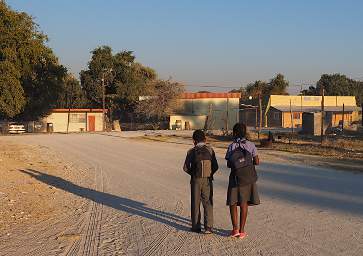 |
| Nafta and Josephine heading off to school | ||
It was a short walk from our house to school, and we enjoyed it. There were usually pigs or goats or a cow wandering around, nibbling on anything they could find including the garbage, which the neighborhood dogs had usually tipped over and emptied. But we also found one rubbish bin whose bottom had rusted out...
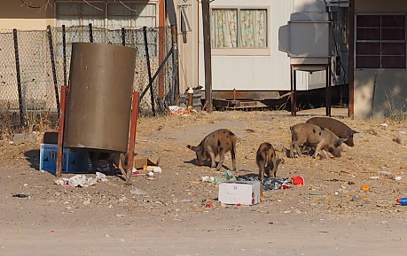 |
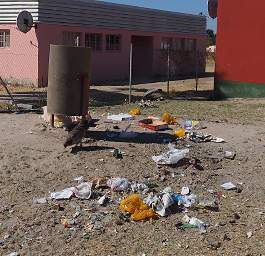 |
| Street Pigs | Hen Pecking at the Garbage |
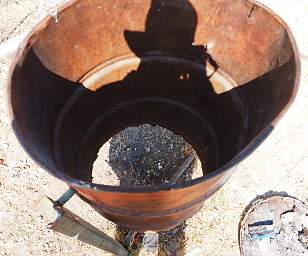 |
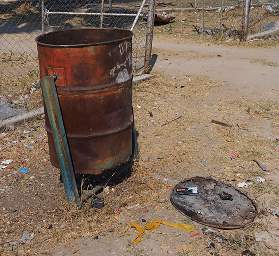 |
| Bottomless Trashbin | Trashbin |
As with many American places, there were too many bars, and over-indulgence in alcohol is a big problem. Our town had more bars than any other type of store.
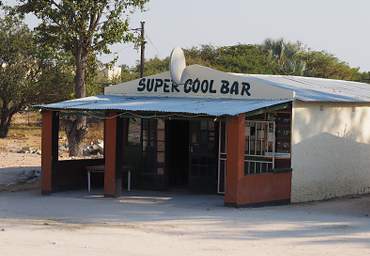 |
| Super Cool Bar |
It was a short walk to the main road as well, where there was a supermarket and we could hitch a ride to Oshikango, the nearest large town 10 km north on the Angola border.
Besides walking, the main mode of transportation in Namibia seems to be taxis, or hitch-hiking. Riding in a taxi and hitch-hiking are pretty much equivalent in Namibia. You stand by the side of the road and wave at the first vehicle that comes along. If it's an official taxi, all well-and-good, and you're off. The driver may stop along the way to pick up more fares. But in addition to taxis, many private individuals will stop and give you a ride as well; you're expected to pay the same fare as you would for a regular taxi. Unlike in the U.S., people are not discouraged from picking up hitch-hikers, and just about everyone hitches because few people own their own vehicles. It's convenient and effective.
Oshikango is a wide-open border town, located mainly in a long strip along the road to Angola. We found pretty much anything we were looking for here, with the exception of some specialty electronic parts. There is a steady stream of goods from the outside world that arrive at the port of Luderitz on the central coast, then travel by truck up to Oshikango. From there some things go on into Angola, and others are unloaded for shops in Namibia. There is a steady stream of people from Angola who cross the border to shop, much like the traffic between Canada to the U.S..
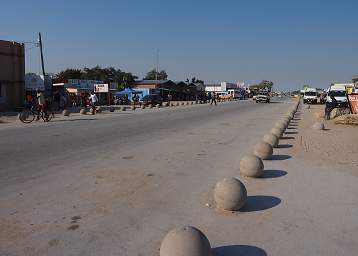 |
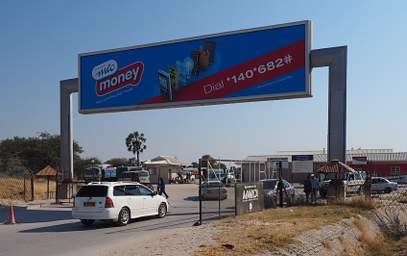 |
| Oshikango Main Drag | Angola Border |
In some ways, Namibia is more progressive than the United States. We saw a new housing development in which every house had a solar hot water heater on the roof. That's something I've never seen in the U.S., even in the southwest where it makes very good sense.
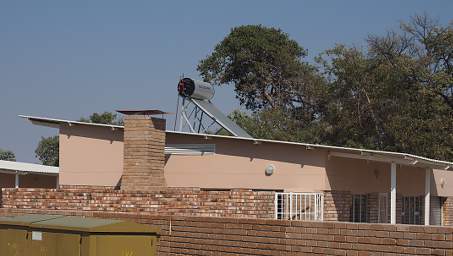 |
| Solar Water Heater on New House |
We were in Namibia during the winter, when it is supposed to be cool. And it was, relatively cool. But relatively cool in Namibia still means I didn't put on a jacked for two whole months, even in the dark and relatively cool of night. Under conditions like those, trees are really appreciated. If there is a tree around a dwelling, that's where you will find any people -- doing whatever needs doing, under the tree. The animals appreciate the shade too... Even in the relatively large town of Oshikango, there were goats wandering around. One day it was really hot, and some of the goats were wandering around the main drag where there weren't any trees. So they holed up under a truck for shade.
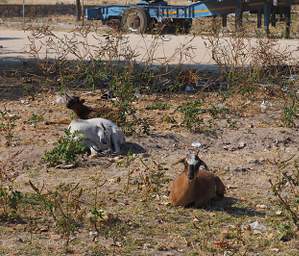 |
 |
| Oshikango Goats | Goats under Big Tree |
 |
| Oshikango Goats in the Shade of a Truck |
With an expanding population, there is always a need for more housing. They were bulldozing the property adjacent to the school to build more houses. I hated to see the vegetation being taken out, but I didn't know the circumstances.
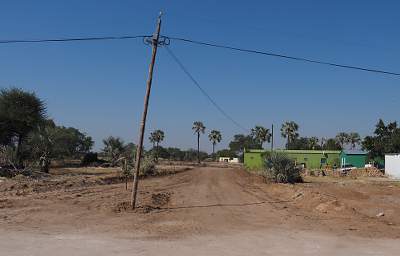 |
| Housing Development outside Ponhofi School |
The Ponhofi grounds were mostly sand, with trees growing here and there. The trees provide welcome shade during the heat of the day. The buildings were of concrete construction with metal roofing; none of the buildings were insulated. The lack of insulation wasn't a problem in terms of staying warm, since the climate is generally warm. I don't know how much of an issue it is with staying cool during the Namibian summer, as we were only there during the cool of winter. I suspect they can get pretty toasty at times.
 |
| Ponhofi Grounds |
Our school day started with a fifteen minute staff meeting at 07:45, which usually started late and ran overtime. It was not particularly efficient, and Mr. Shinedema, the principal, was clearly frustrated sometimes. He had to walk a fine line between encouraging people to have their say and getting work done. Despite the fact that religion is not supposed to be part of school in Namibia, our meetings always ended with a bible reading of some kind. At one time the reader reminded everyone that merely associating with a non-believer was likely to land you in Hell. Despite that, our presence caused no real problems other than a reluctance on the part of some to be involved in some social events. Events where alcohol was present were also taboo for the same folks, and almost any braii included alcoholic drinks of one form or another. As with most religious prohibitions, there was a lot of hypocrisy.
Twice a week in the morning the whole school gathered outside the administration building for an assembly. A group of learners was always assigned the task of singing at the start of the assembly. It didn't seem to matter which group of learners was assigned; it was always acappella and they all sounded great. At the end of the assembly the whole school sang the Namibian national anthem as the flag was raised, and then the Ponhofi school song.
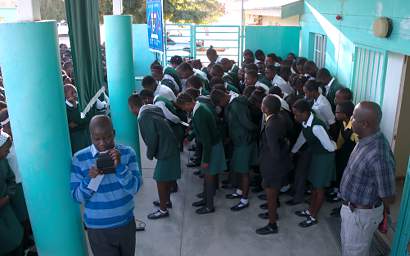 |
| Singing at the Morning Assembly |
 |
 |
| Morning Assembly | Mr. Shinedima (Principal)
addressing the learners |
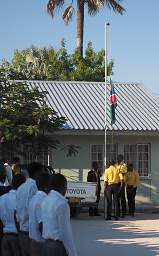 |
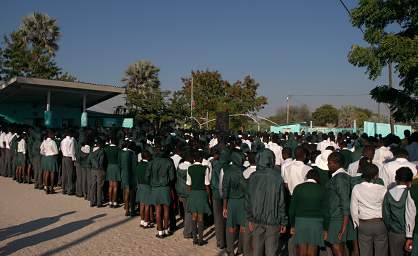 |
 |
| Raising the Namibian Flag at Assembly | ||
After the flag is raised and the national anthem sung, the learners turn to face the teachers and sing the school song.
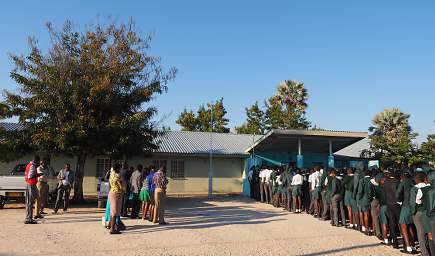 |
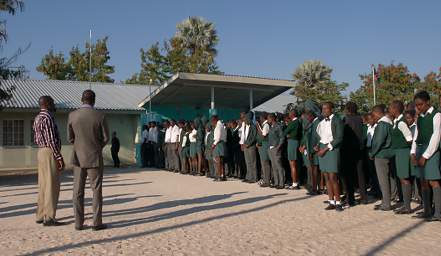 |
| Teachers at the Morning Assembly | Singing the School Song |
I loved all the different hairstyles the girls wore, but there's no way I could stand taking the kind of time they did to make them!
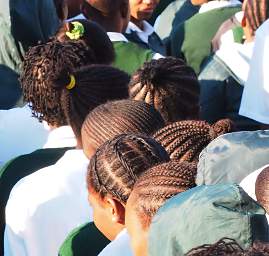 |
 |
| Heads | |
The standard school uniform consisted of a white shirt or blouse and green trousers or skirt and possibly a green sweater or jacket. One learner from each class-year is elected as the "head boy" and another as the "head girl," and they get to wear a yellow shirt. It's a nice distinction; they're easy to find if you need them, and it gives them some much-appreciated attention.
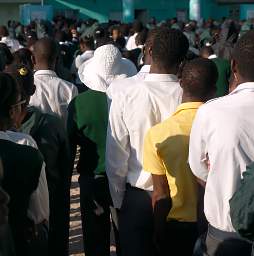 |
| Yellow Class Head |
Dona and I did a crash course on effective teaching before we left home; in addition, our World Teach orientation session had spent time discussing lesson plans and effective teaching. Unfortunately, it didn't do me much good for the first month, as I didn't have any fixed schedule or classes I could consider my own. Instead, I helped wherever it was most appropriate, a situation which either demanded an impromptu lesson, or just short pieces here and there.
The computer lab at Ponhofi consisted of a single server running Microsoft Server 2003, and twenty thin client workstations. So twenty seats for a student population of 1200, with an average class size of about 40. That meant things were excrutiatingly slow if you had a class doing more than one thing. Really slow. As in really, really, really slow. As in sometimes wait several minutes for things to happen.
Unfortunately, I didn't know what the computing environment was going to be until I arrived. If I had known in advance, I would have / could have brought some resources to help. I'm not an MS Server guru, and most resources / discussion groups are pretty much U.S. oriented. That means half a world away, and responses were pretty slow because of the time difference. In addition, the lab was in use most of the day, and I didn't want my research into improving things to slow down learners who were trying to learn something. That meant I had to do most of my research after-hours. Dona spent quite a few evenings as a computer widow, and we didn't wander around as much as we might have otherwise.
In any case, I identified three main problems:
There were a number of other problems, such as learners breaking the mice by picking at the trackball with a sharp object, breaking mice by drawing on the optical sensors, messing up displays by drawing on them with a pen, and putting displays in some weird state from which it was almost impossible to recover. How did they do that??? Eventually I found / devised solutions to most of these problems, but it was pretty frustrating.
When the computers were slow, learners would usually click again, or click on something else to see if that worked. Every click just made things worse, starting yet another process which bogged the server down even more. Or else they would get bored and just fiddle with the desktop, moving icons around, duplicating things, triplicating things, quadruplicating things, ... duodecalicating things. Before I fixed it, after a class I would walk around check to see that the desktops were in a standard configuration; often I would find them with fifteen copies of different language setups, three copies of shortcuts to firefox, six copies of microsoft access running, etc.
Sometimes I wanted to yell and scream, but I managed to avoid that pretty much. I kept reminding myself it wasn't just the learners' problems. If I were a learner and the computers weren't working, or werent' responding very fast, I'd probably do just what some of them were doing.
Oh, yeah, there were plugs in the floor to power all the workstations. Except some of the plugs weren't working, and sometimes there weren't enough extension cords to reach them all because someone had borrowed one of them for some other purpose. Once someone found an ethernet cable which was unplugged (for a reason...) and just plugged it in somewhere. They happened to plug it back into the router from which it came, creating a loop which totally bogged down the network.
I eventually came up with a list of three things I wanted to accomplish:
In spite of all those issues, I would do it again if I could. I'm not sure if we'll be able to do that, but it's not out of the question.
When I arrived at Ponhofi, Sho Tamagawa, a volunteer with the Japan International Cooperation Agency, was already there. He was four months into a two year stint and pretty frustrated. We got along pretty well, and it was good to have another head to bounce thing off. The head of the IT curriculum, Theo Mwashindange, as also helpful.
Initially, there weren't enough cables to reach all of the workstations, so they were running from wireless routers. It was also difficult to wire them, as there were no raceways for wiring and we didn't want learners tripping over cables. The ceiling was just corregated metal, so I devised some hangers we could pop-rivet to the ceiling and then string cable through wire-ties. Not very elegant, but it worked pretty well.
 |
 |
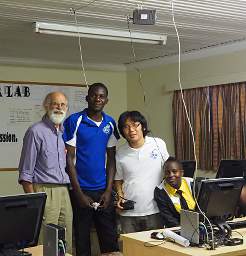 |
| Rewired Computer Lab | Gary and Sho in the Computer Lab | Gary, Mario, Sho and Xxx |
Sho had bought some new outlets to replace the non-functioning ones in the floor. Eventually I made time to take apart one of the broken ones, and discovered they were just filled with 20 years worth of sand. Did I mention it was sandy here? The power distribution panel wasn't labelled, so we didn't know which circuit breaker controlled what. The first time I started to look into one, the whole lab went dark. My first thought was "oh, dangit ..." But then Theo said he could hear the generator running over at the hospital, and it turned out there was a general power outage. Anyway, all we needed to do was take the outlets apart, clean, and reassemble. Hopefully they'll run for another 20 years.
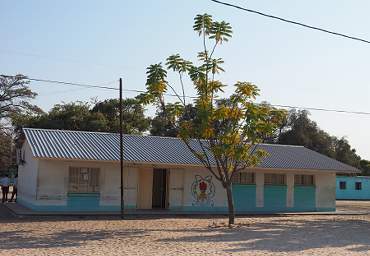 |
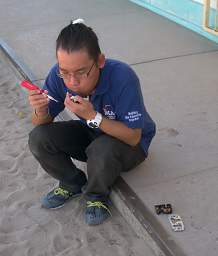 |
| Computer Lab | Sho Fixing Outlets |
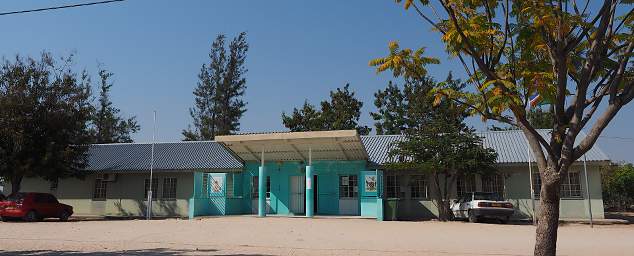 |
| Administration Building |
There is a war memorial on the school grounds, in memory of three learners and one teacher who gave their lives in the struggle for independence.
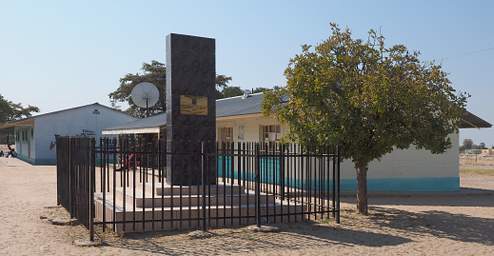 |
 |
| Ponhofi War Monument | War Monument Plaque |
I stayed pretty late working at the lab, and often walked home in the dark. Sometimes I was lucky and headed home just after sunset, when the sky was lit up. On a few occasions, we even had some clouds for the light to reflect off of, but usually there were just stars or the moon.
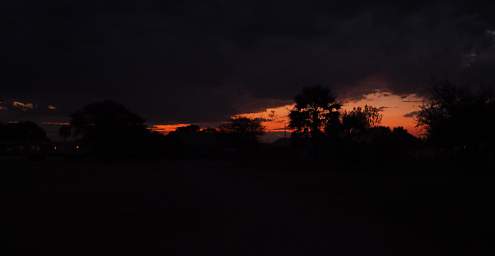 |
| Ponhofi Sunset |
Namibian kids love to have their picture taken -- even though we didn't have a way to print the images and give them to them. They just liked to have their picture taken. One day I went to one of Dona's classes to get photos of her working with her learners. I was standing at the back of the class, and as soon as I brought the camera up to my eye one of her learners jumped up, ran up front, and put his arm around her to get in the picture.
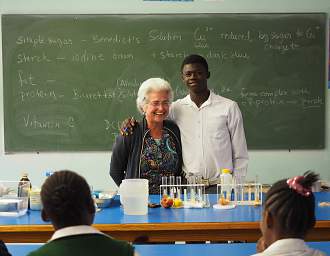 |
| Bio Lab, Dona and Xxx |
At first Dona shared classes with her Namibian counterpart, Lydia; but that turned out to be awkward because of their different approaches. So they split the classes and Dona taught half and Lydia taught the other half. That worked out much better.
 |
 |
 |
| Bio Lab, Dona and Lydia | ||
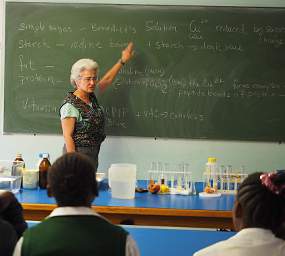 |
 |
| Bio Lab, Dona | |
One of the things we brought from home was a projector, and it made a big difference. Dona spent a lot of time preparing slide shows for her class sessions, and it helped the kids a lot. At first the kids didn't quite know how to deal with this. Many Namibian teachers simply feed the textbook back to the students, so there's nothing in the class session they can't find in their book. But Dona's lessons were completely not in their book, although the same topics were covered. Her explanation was often more in depth, and she brought all the parts together so the students could see how one system related to, and affected, another.
 |
| Dona with Students in the Bio Lab |
 |
 |
| Dona with Students in the Bio Lab | |
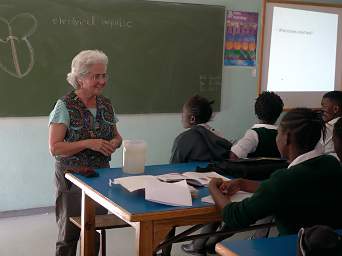 |
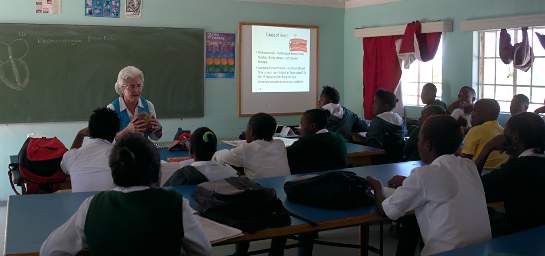 |
| Discussing how the heart works | |
Dona brought a stethoscope and a blood pressure cuff with her. Unfortunately, we only had one of each. None of her students had ever had their blood pressure taken, or either listened to a heart or had their heart listened to. They were all eager to try them out.
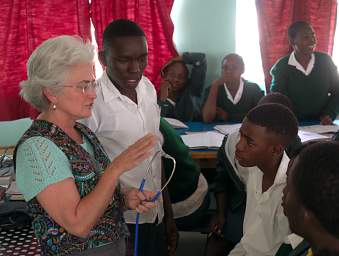 |
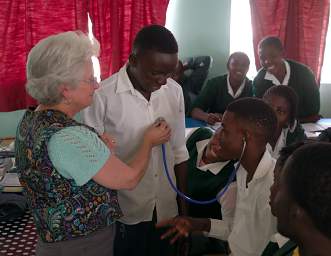 |
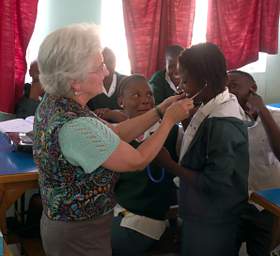 |
| Explaining How to Use a Stethoscope | ||
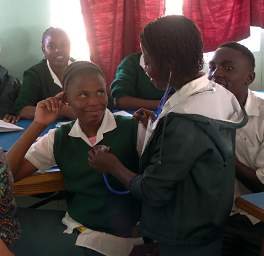 |
 |
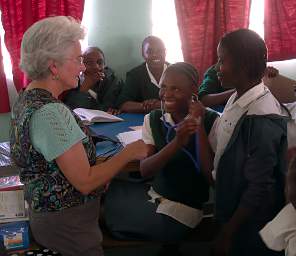 |
| Learning by doing | ||
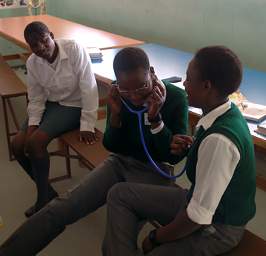 |
The blood pressure cuff was a bit trickier.
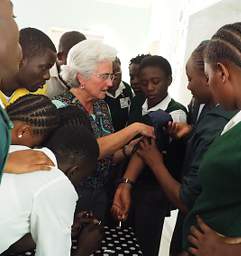 |
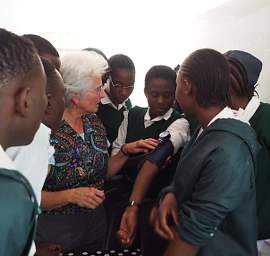 |
 |
| First you put the cuff on. | Then you pump it up. | And slowly let the air out. |
 |
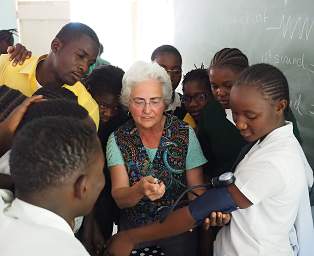 |
| And again... | |
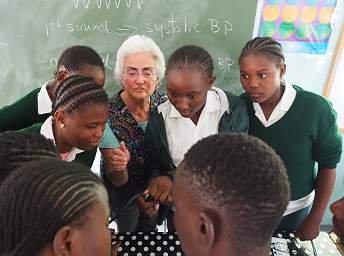 |
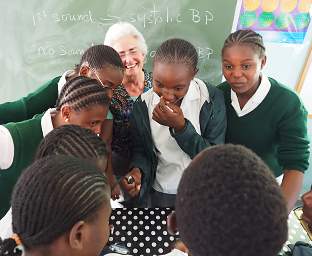 |
 |
| Learners trying it for themselves | ||
Dona also brought an EKG with her, graciously donated by the Vernier Corp. . At first we had trouble getting a good trace from it, until we discovered the AC power was radiating / transmitting all sorts of noise. So we unplugged the computer and projector, ran the computer on battery while Dona was recording the EKG, then plugged the projector back in to display the results.
 |
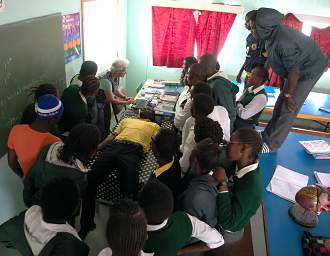 |
| Doing an EKG of Mario | |
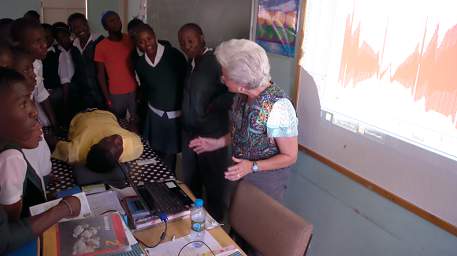 |
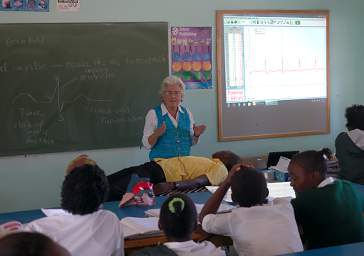 |
| The projector or power strip caused noise in the EKG... | |
| Note noise in the signal | Note nice clean signal;
it now looks like Dona's drawing on the board |
Before we left, Dona found a place where she could pick up some small hand microscopes pretty inexpensively, so we brought a few of them over with us. She made good use of them in the biology lab.
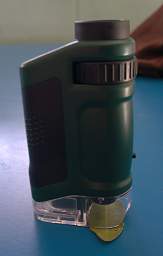 |
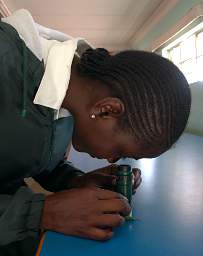 |
| Pocket Microscope | |
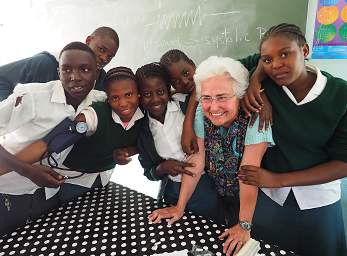 |
| A picture for the sake of a picture |
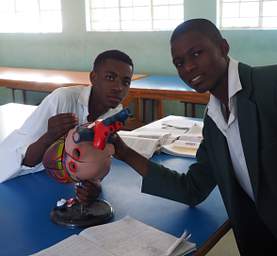 |
 |
| Bio Lab Students Posing with the Heart Model | |
After one month at our schools, all of the World Teach summer volunteers returned to Windhoek for a weekend "mid-term" session. Bret had arranged for a Ministry of Education vehicle and driver to take us down; the whole trip was a great example of third world inefficiency. The driver was supposed to pick up Diane at 8:00; he arrived two hours late. Part of his excuse was he needed to wash the car... After picking up us and Fletcher and Katy, we went to the cleaners to pick up some of the driver's clothes, which we then dropped off at his mother's. We drove on for a bit, then stopped at a roadside table to wait for a guy going north to whom the driver needed to give some papers.
When we stopped to pick up Fletcher at his school, a big group of kids was there to see him off. I had gotten out to stretch a bit and wanted to interact with the kids, but they didn't speak much English and I didn't speak hardly any Oshikwanyama. I started doing high fives with them and that broke the ice. They got a kick out of it and were having fun, but seemed a little reluctant. Then I picked up one and held him out and spun around for an airplane ride. They really liked that and started crowding around for turns, but unfortunately we didn't have time to do all of them...
 |
| Hi-fiving the Shikadule Kids |
We stopped for lunch at the market in Omuthiya. The food was great, as it always is at the Namibian open markets; much better and much more enjoyable than the crap we get at fast food places when you stop by the highway in the U.S. Every market has several vendors making "kapana", a marinated sliced meat grilled over a hot bbq with onions, tomatoes, spices and whatever else is on offer. The meat is usually cut up more or less on the spot by a separate meat vendor at the market. Yumm!! There are usually also vendors selling "fat cakes", which are sort of like a donut without the hole; best when hot off the grill! It's pretty easy to eat too many of them.
 |
 |
| Omuthiya Market | Typical market stall with a little of everything --
Bowls and Goblets for tourists; Grains for everyone; and Phone cards |
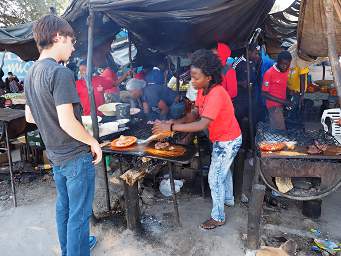 |
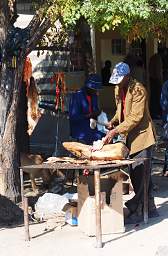 |
| Fletcher Waiting for his Kapana | Man Cutting Meat |
We were way behind schedule because of all the detours and extra stops, so the driver tried to make it up; I didn't really like going 100mph (160 km/hr) down a two-lane road, even a good one. We finally arrived in Windhoek at 20:00. Backpacker Unite was full so Bret had booked us into another place; and luckily he had dinner waiting for us.
A bonus was they also had some nice birds hanging around.
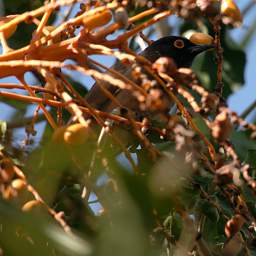 |
 |
| African Red Eyed Bulbul | White Backed Mousebird |
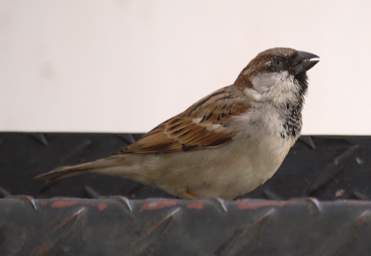 |
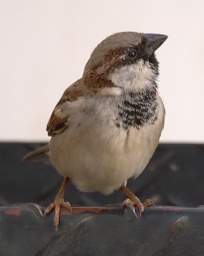 |
| Xxx House Sparrow | |
We spent a day discussing any issues we had; mostly I think it was good to come up for air and hear how everyone else was doing. It helped one feel a little less isolated and realize any problems you might be having weren't really all that bad.
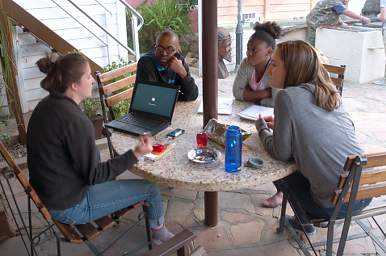 |
| Diane, Paavo, Jessica and Katy |
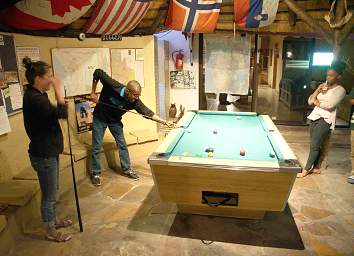 |
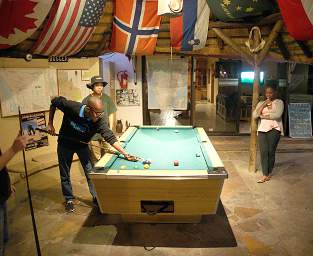 |
| Diane, Paavo and Jessica | Paavo, Shawn and Jessica |
As we headed back north we passed some great murals on a wall separating a housing area from the highway.
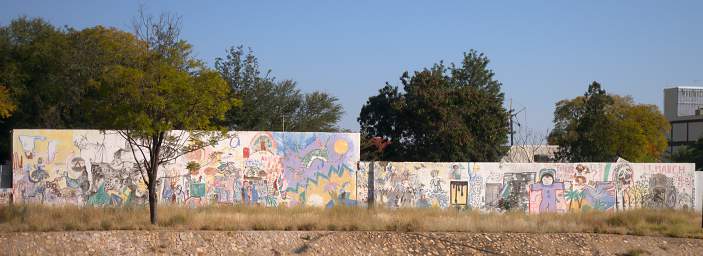 |
| Murals in Windhoek |
When we got to Okahandjo things came to a grinding halt. One of the Herero peoples' chiefs had been assassinated a day or two earlier, and his funeral was taking place. We pulled off and waited for the procession to pass. The honor guard rode horseback.
 |
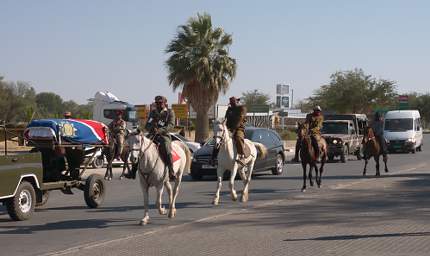 |
| Herero Chief's Funeral | |
 |
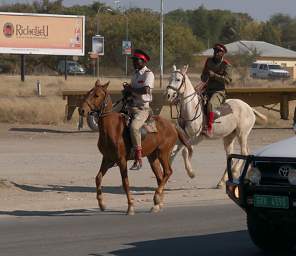 |
The truck we rode in back north didn't have room for all of us up front, so we traded off riding in the back.
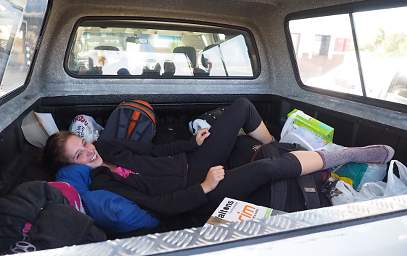 |
| Diane resting in the back of the truck |
My co-worker, Sho Tamagawa, had fairly strict parents, but they were back in Japan and he was in Namibia. One day he decided he would "go Namibian" with his hair, so he talked a few of the learners into doing it for him. It took a few hours; he was pleased with the result.
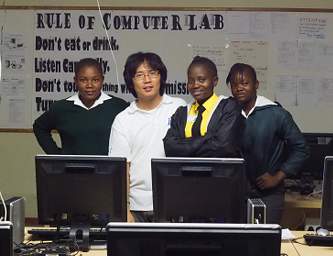 |
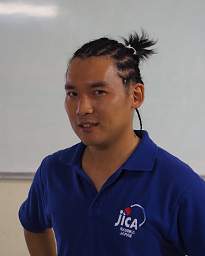 |
| Sho and some of his Girls
before Restyling his Hair |
After Hair Styling |
Sho had another Japanese guy in his program whose job was to support the other volunteers with hardware issues. His name was "Yuta Aihara," and Sho arranged for him to visit us and help with rewiring the lab. In the process, we had him show the students how a category 5 ethernet cable was made.
 |
| Yuta Aihara with Ponhofi Learners |
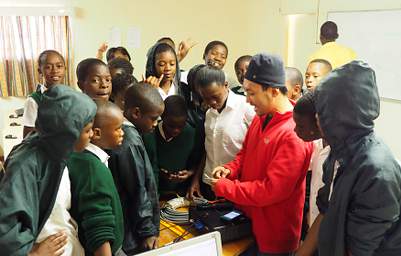 |
 |
| Yuta showing learners how to make an ethernet cable. | |
You'll notice in some of these pictures of learners that some of them are wearing sweaters and light jackets, and in some cases, finger gloves. The girls' uniform included a lightweight green sweater, and many also wore a dark green hooded jacket. Despite the warm climate, or maybe because of it, the learners seemed to get cold in conditions I considered perfect shirt-sleeve weather.
We learned that for Fourth of July weekend most of the Peace-Corps volunteers and the year-long World Teach volunteers were going to be getting together in Ongwediva at "Patrick's place"; Patrick being a Peace Corps volunteer who had somehow scored a nice house. Diane was meeting up with Fletcher and Katy and going there; Dona and I hitched a ride down as well. It was a pretty good slumber party, and it was good to meet the other volunteers in our part of Namibia. It was a pot-luck and we brought chocolate-chip cookies, a real treat because chocolate chips are not easy to come by. But the real treat was pretzels an older volunteer (whose name I can't remember) out in the bush had made. We quizzed them for info that might be of use when traveling, as most of them had traveled around quite a bit.
 |
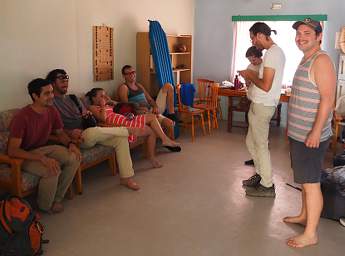 |
| Fletcher, Katy, Martha and Dona
at Patrick's |
Patrick is the guy on the far left |
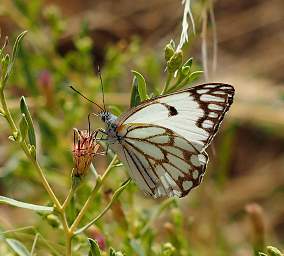 |
| Butterfly |
The weekend we were in Ongwediva they were having a big trade-show / cultural fair, so we headed over there before heading home. Unfortunately it was the last day and we were late in the day, so we missed the parade and some things were already taken down. But we had a good time and some of the girls bought traditional dresses and a few handicrafts.
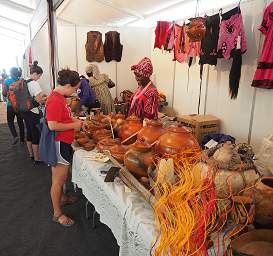 |
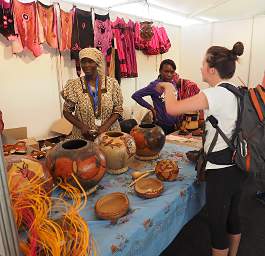 |
| Martha checking out Bowls
at the Ongwediva Fair |
Diane at the Ongwediva Fair |
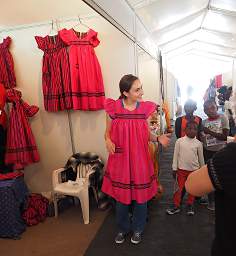 |
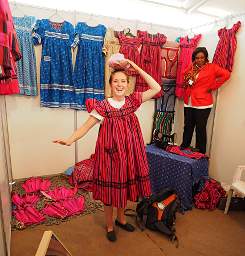 |
| Katy trying on a traditional
Oshiwambo Dress |
Diane trying on a traditional
Oshiwambo Dress |
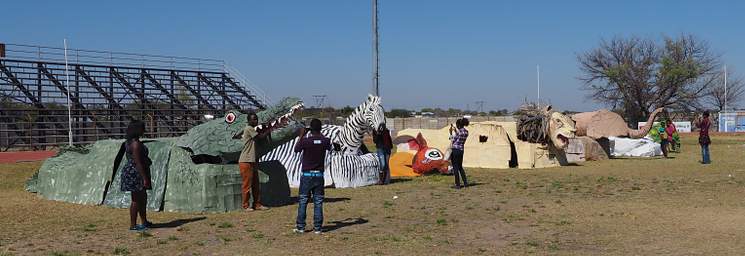 |
| Floats for the Ongwediva Fair |
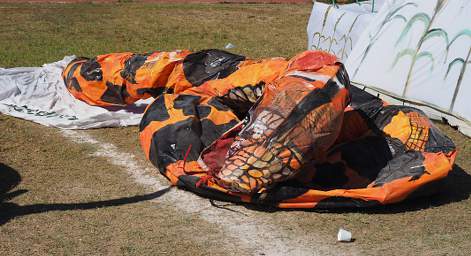 |
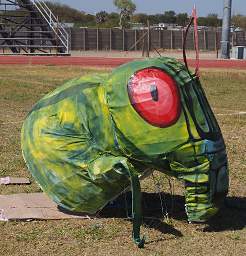 |
| Serpent Float | Xxx Grasshopper Float |
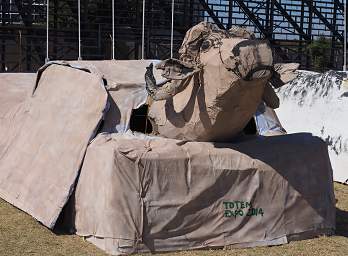 |
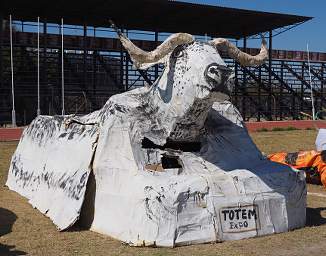 |
| Cape Buffalo Floats | |
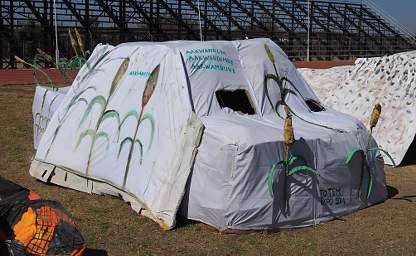 |
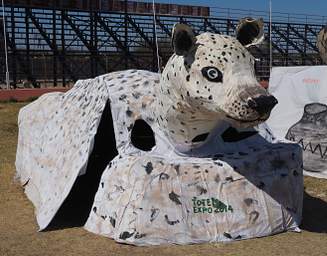 |
| Mahangu (Millet) Float | Hyena Float |
 |
 |
| Float of Traditional Pots | Xxx Float |
 |
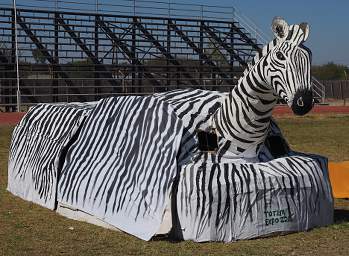 |
| Crocodile Float | Zebra Float |
 |
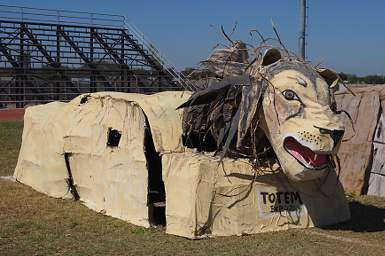 |
| Hare Float | Lion Float |
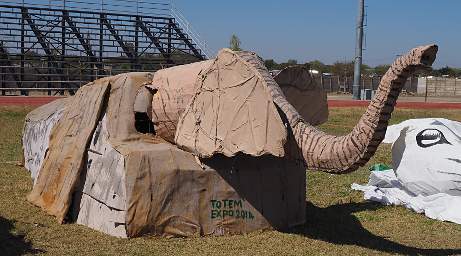 |
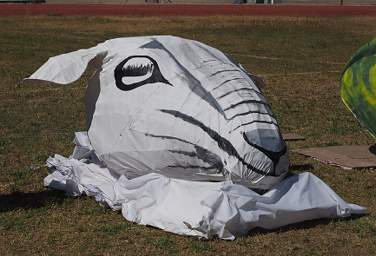 |
| Elephant Float | Xxx Zebra Float |
Northern Namibia is known as the basket making place, and we had seen lots of baskets -- everyone uses them all the time, and we had seen some huge ones used to store grain. But we had not seen any place where people actually made baskets. We had looked on our trip to Huab Lodge but come up short. When we asked about it, no-one seemed to know where they were made other than the ones people made for themselves at home.
The Bradt guidebook said there was a basket-making co-op in Engela, a small town near the Angola border, so one weekend we headed up there with Sho and Mario, one of our students familiar with the region. We wandered around asking people if they knew of any place where people made baskets, but no-one seemed to know. Many knew someone else who was supposed to know, but when pinned down we always came up short.
One thing we did find was a big important tree a Chinese construction crew had bulldozed, causing a huge outcry. It was in the path of a road they were constructing, and rather than go around it to preserve it they had just bulldozed it down. Not smart, and a terrible waste in this land of drought.
 |
| Tree Bulldozed by Chinese Road Crew, Engela |
On our way to a mission where they were supposed to make baskets we came to the Engela hospital, a facility regionally known for its good care. There were a lot of brightly colored tents pitched just outside the hospital. When we asked who was staying in them, we learned that people waiting to be admitted or people with a family member in the hospital stayed there.
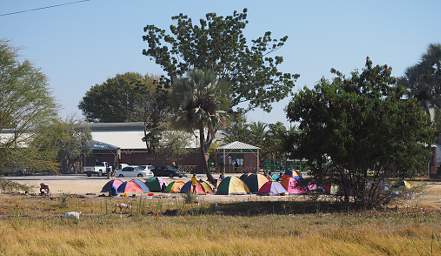 |
| Engela Hospital Visitors |
On our way to the mission we passed a house that used a form of construction I have never seen which was rather intriguing. It appeared to be some sort of pre-fab construction with inflated walls, and I was curious whether it used some kind of blown-in insulation. We didn't find out, unfortunately.
 |
| Engela House with Soft Sides -- inflated? |
When we got to the mission we found this great tree, a combination Palm and Mopane. But the people at the mission had no program for making baskets, and told us they hadn't been made there for quite a few years.
 |
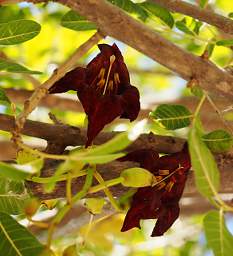 |
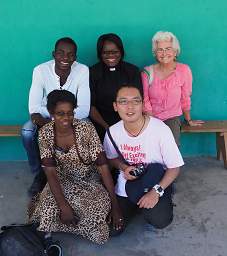 |
| Combo Tree | Flower | Mario, Xxx, Dona, Xxx, Sho
at the Engela mission |
We left the mission and hitched a ride back to Oshikango, where we met up with Fletcher, Katy and Diane. Sho led us on a trip through the Oshikango open market, where we had some great Kapana and Diane and Katy again tried on clothes. Katy found one she liked and wore it out.
 |
 |
 |
| Diane and Katy trying on Dresses | ||
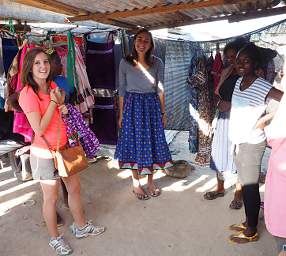 |
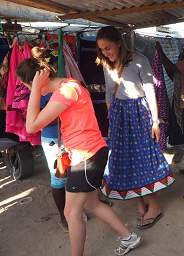 |
| Katy's New Dress | |
 |
| Child Sleeping at Oshikango Market |
One day when we got up Nafta and Josephine informed us that someone had stolen their puppy. All they had was a shoe-print to identify the thief, and they never found him. They were pretty upset, and there wasn't much we could do to help.
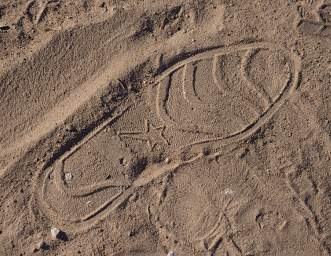 |
| Footprint Dog Thief |
Sometimes it is difficult to find a quiet place to study at Ponhofi. There are somewhere around sixteen kids to a room in the dorms, and there's no real study-hall where it is quiet. Sometimes the library is quiet, but it's not always open; and the regular class rooms are often noisy when not occupied during a lesson. So the kids study where they can.
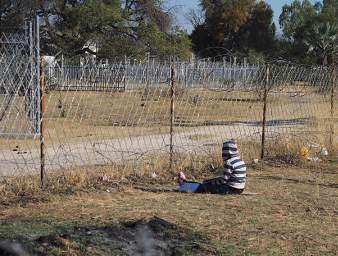 |
| Ponhofi Learner Studying |
For some classes, learners lined up outside the classroom and waited to be invited in by the teacher. It was up to the teacher to encourage this behavior, and I think helped to create an orderly class situation.
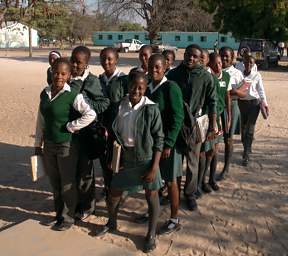 |
| Ponhofi Learners Lined Up |
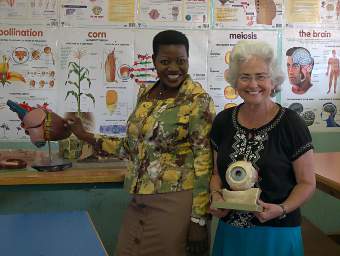 |
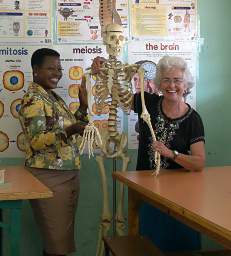 |
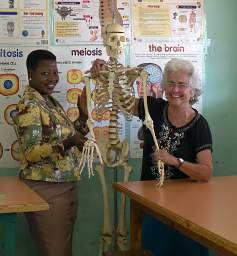 |
| Lydia and Dona | Lydia and Dona with the Biology Skeleton | |
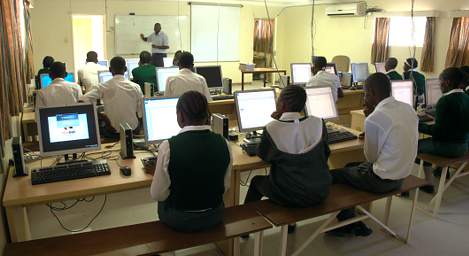 |
| Mr. Mwashindange in the Computer Lab |
Dona made herself available outside of the classroom for extra tutoring; students liked that and made use of it, especially in the week before their big national exam.
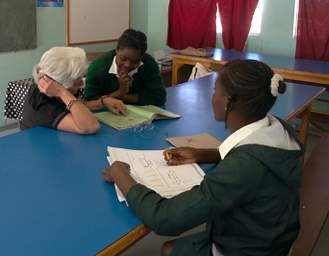 |
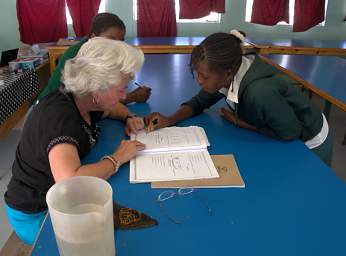 |
| Dona Tutoring | |
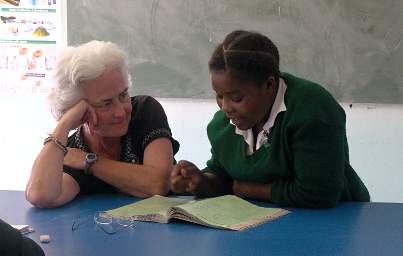 |
| Dona Tutoring Foibe |
I spent most of my time in the computer lab. The older learners usually practiced their word-processing skills writing a resumé. They always wanted to print it, but it was usually full of mistakes. Because using the printer was deemed expensive, we proof-read them before printing. That turned out to be a good learning opportunity, explaining how to fix various problems. Some of them learned from the experience; but many just wanted to fix it and get the hard copy. When you are a poor person, having a real piece of paper with something you wrote is a big deal.
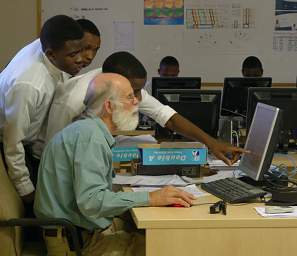 |
| Gary in the Computer Lab
hmmm... I should work on my posture while learners work on their word-processing skills... |
And then, way too quickly, it was time to leave. We weren't ready to leave, and I think the principal and our co-teachers would have liked us to stay longer. It was in the middle of exam time. We learned a new word -- "invigilate"; and our Namibian counterparts learned a new word -- "proctor". We had a small party; Dona baked up a batch of cinnamon rolls which were a big hit.
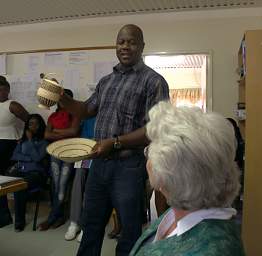 |
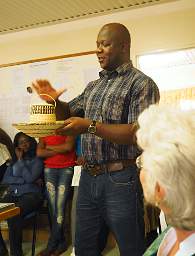 |
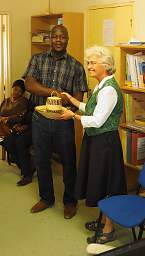 |
 |
| Mr. Shinedima and Dona with Baskets and Certificate of Appreciation | |||
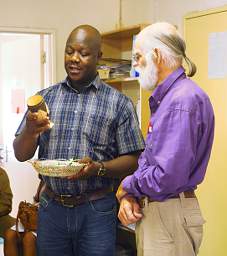 |
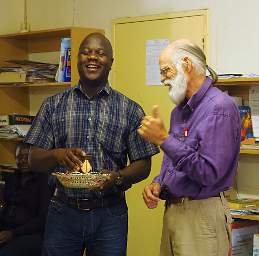 |
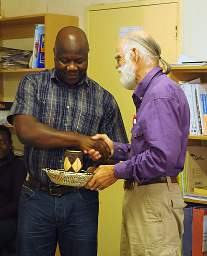 |
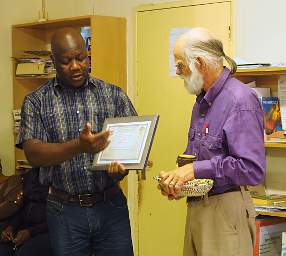 |
| Mr. Shinedima and Gary with Cup, Basket, and Certificate of Appriciation | |||
 |
| Mr. Mwashindange |
We took some group photos which are all here in case someone wants to print a particular one.
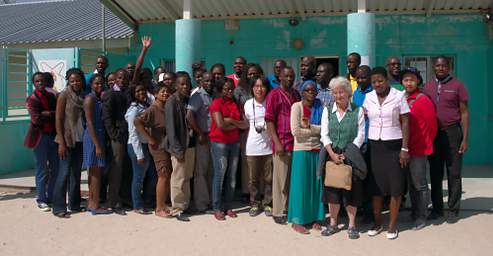 |
| Ponhofi Teachers |
 |
 |
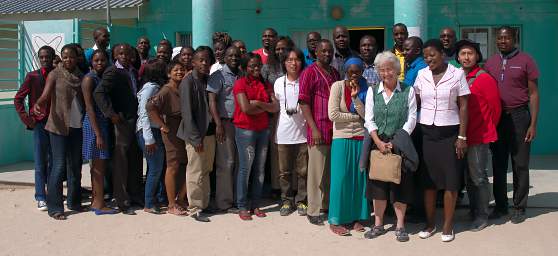 |
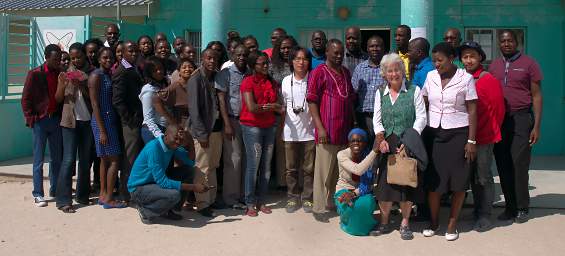 |
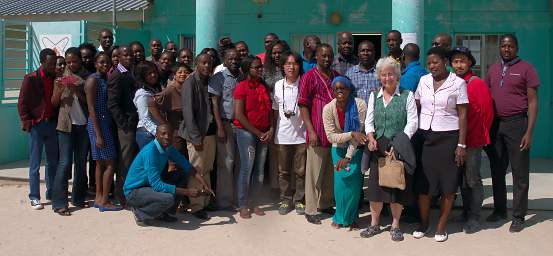 |
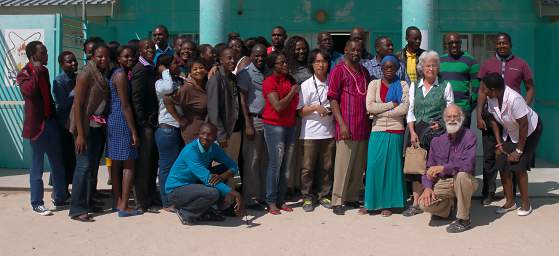 |
 |
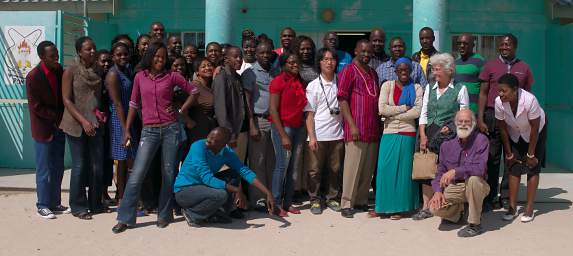 |
| Ponhofi Teachers |
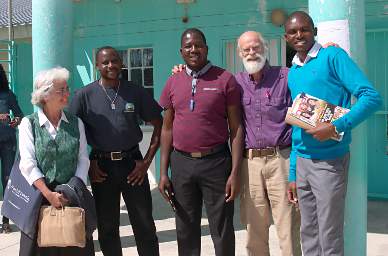 |
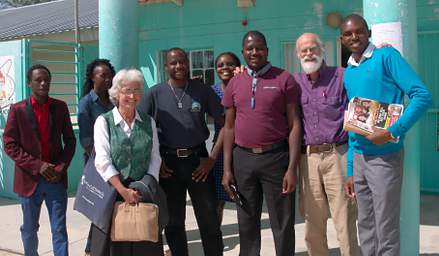 |
| Dona, King George, Simon, Gary and Imms | Xxx, Xxx, Dona, King George, Xxx, Simon, Gary and Imms |
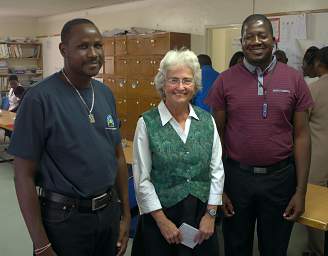 |
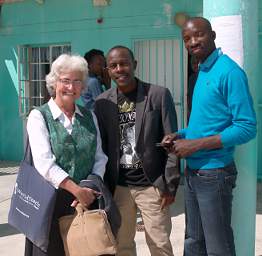 |
| King George, Dona and Simon | Dona, Pubari Katundu and Jerobeam Nande |
On our last night my co-teacher, Theo Mwashindange, organized a braii. As usual for this time of year, the weather was perfect. We had a good time with Kapana, Boerewors (sausage), Mahangu and drinks. Yum! Mr. Theo was the braai-meister, and everything came out great.
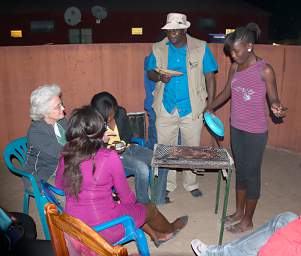 |
 |
| Dona, Theo and Martha | Mahangu |
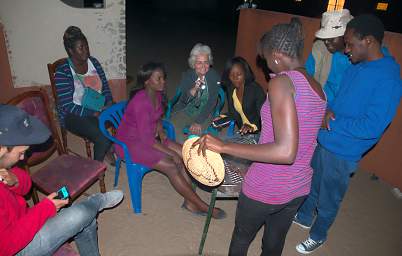 |
 |
| Yuta, Lettie, Xxx, Dona, Xxx, Martha, Theo and Xxx | Theo, Martha and Yuta |
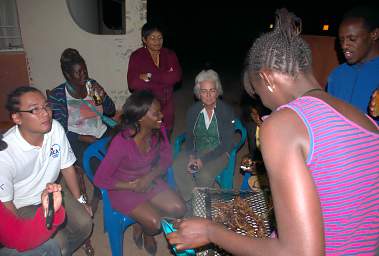 |
| Sho, Letti, Xxx, Mary, Dona, Martha and Xxx |
 |
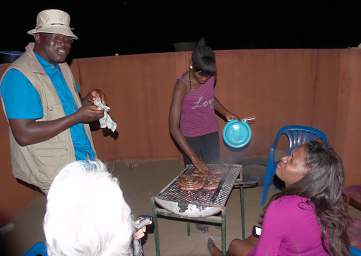 |
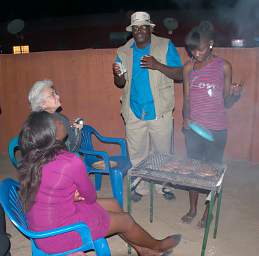 |
| Theo putting on the Boerewors | Theo, Martha and Xxx | Xxx, Dona, Theo and Martha |
Traditionally, people eat mahangu with their fingers, so there is a bowl for washing up before and after eating. Our family provided a nice bowl with a tea-pot of warm water.
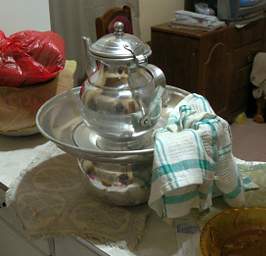 |
| Hand Wash |
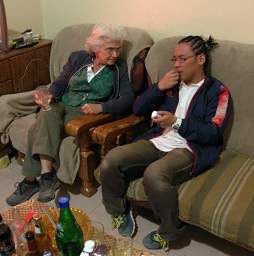 |
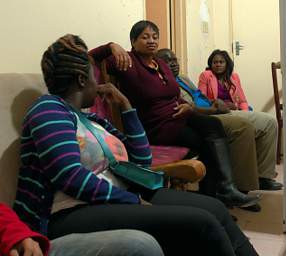 |
 |
 |
| Dona and Sho | Lettie, Mary, Theo and Xxx | Lettie | |
The Ministry of Education was scheduled to have a vehicle pick us up at 08:00 for the long drive down to Windhoek. On the appointed day, they were almost two hours late. The regular school assembly was taking place that day, and we were asked to say a few words. I was pretty ineffective as an impromptu speaker. Dona was back at the house waiting, in case the driver showed up there instead of at school. One of our co-teachers gave Dona a nice Himba / Herero necklace, as that is his ancestry; and me a bracelet.
When the vehicle finally showed up, it was a small Toyota sedan. It was a classic screw-up, barely large enough for Dona and me and our bags; but where were we supposed to fit Diane and Fletcher and Katy? We ended up driving down to Shikadule, where we waited by the highway because the driver didn't want to drive in to the school itself where Fletcher, Katy and Diane were waiting at Fletcher's place. We called Bret and told him the situation, and he pestered the Ministry of Education who pulled in a truck from somewhere. The truck eventually showed up and we swapped the sedan for the truck, and drove in and picked up the rest of our crew. Fletcher's kids were clearly sad to see him go, and gathered around the truck as he climbed in the back with Katy.
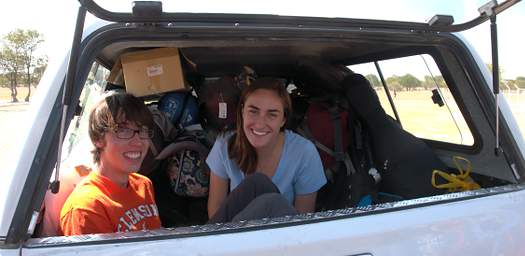 |
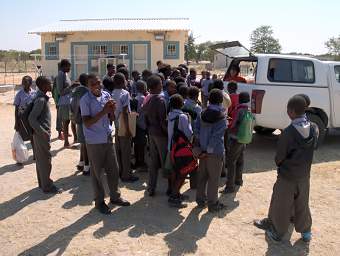 |
| Fletcher and Katy | Fletcher and his Learners |
Then we headed out, stopping on the way to take a photo of a great termite mound.
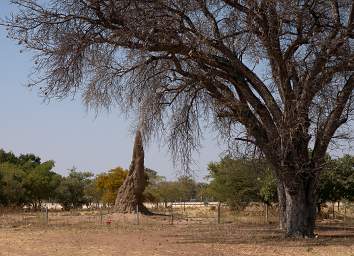 |
| Termite Mound near Shikadule |
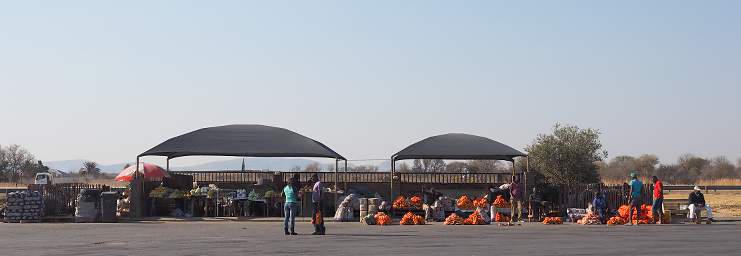 |
| Market with lots of Oranges |
Bret had dinner waiting for us at Backpacker Unite, and the next morning we loaded up a big van with camping gear and headed for Etosha National Park!